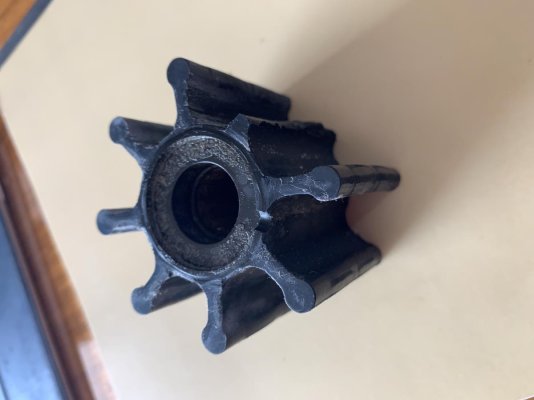- Joined
- Mar 17, 2012
- Messages
- 4,279
- Location
- Australia
- Vessel Name
- Insequent
- Vessel Make
- Ocean Alexander 50 Mk I
I seem to recall discussions from time to time regarding the frequency of raw water pump impeller changes, but could not readily locate a thread on it.
For my starboard engine I have changed the raw water pump at 2 or 3 year intervals due to failed seals, and thus changed the impeller.
Yesterday, during a 2000 hr engine service when we did a lot of things 'whether they needed to be changed or not', we changed the port engine impeller. Its raw water pump seals had not leaked, and since the engine was always at normal temp I had not checked or replaced the impeller.
So the mechanic was just as curious as I was to see what it would look like after 7.5 years and 2000 hrs of use. The pic is below. Sure, one vane was gone but otherwise it was working fine. But we changed it anyway!
For my starboard engine I have changed the raw water pump at 2 or 3 year intervals due to failed seals, and thus changed the impeller.
Yesterday, during a 2000 hr engine service when we did a lot of things 'whether they needed to be changed or not', we changed the port engine impeller. Its raw water pump seals had not leaked, and since the engine was always at normal temp I had not checked or replaced the impeller.
So the mechanic was just as curious as I was to see what it would look like after 7.5 years and 2000 hrs of use. The pic is below. Sure, one vane was gone but otherwise it was working fine. But we changed it anyway!

